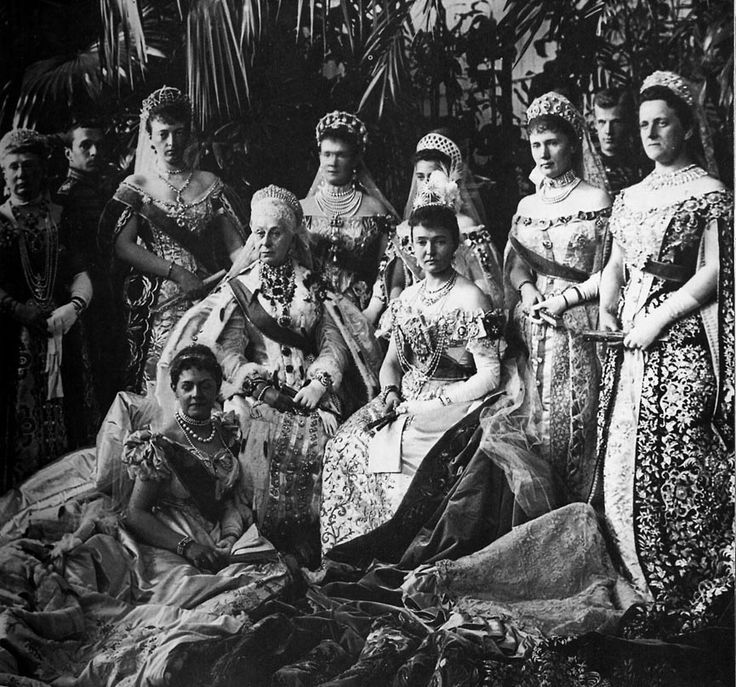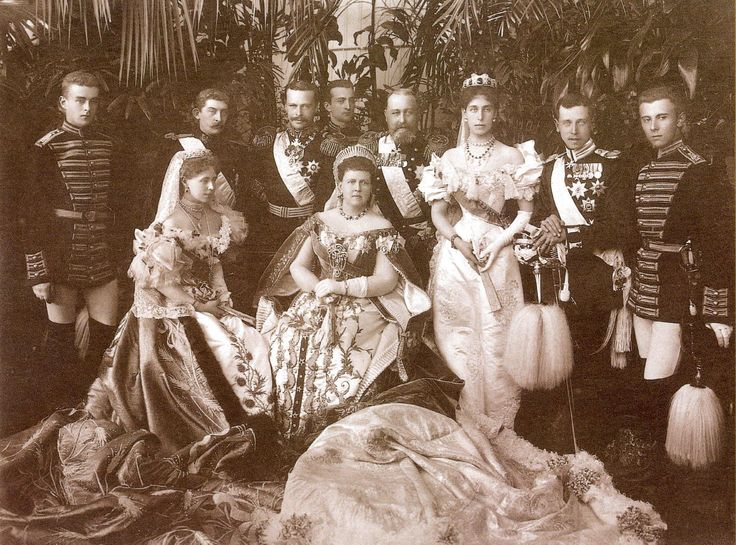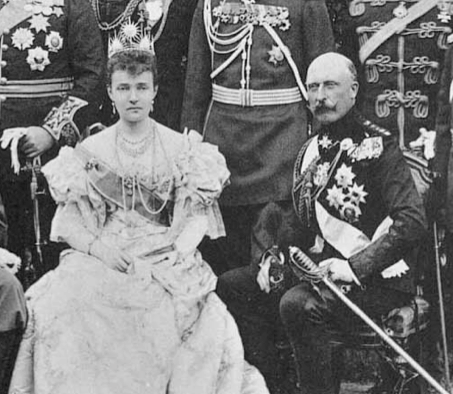 |
| Royal ladies during the 1896 coronation: (seated, L-R) Princess Olga of Wurttemberg; Grand Duchess Alexandra Iosifovna of Russia; Princess Louise Margaret, Duchess of Connaught; (standing, L-R) Grand Duchess Vera Constantinovna, Duchess of Wurttemberg; Grand Duchess Anastasia of Mecklenburg-Schwerin; Grand Duchess Maria Pavlovna of Russia; Grand Duchess Elena Vladimirovna of Russia; Grand Duchess Elizabeth Mavrikievna of Russia; Princess Elena of Saxe-Altenburg |
Though somewhat late in the programme of festivities, the dinner given by the British ambassador to-night in honour of the coronation was a brilliant function. The Embassy was illuminated. The arrival and departure of the Emperor [1] and Empress [2] were witnessed by large crowds, who cheered vociferously.
The guests sat at one long table, which was decked with flowers and laden with gold and silver plate. At the middle of the table on one side sat the Czar, with the Duchess of Connaught [3] on his right and Lady O’Conor [4] on his left. On the opposite side, facing her Imperial husband, was the Empress, with the Duke of Connaught [5] on her right and Sir Nicholas O’Conor [6] on her left.
 |
| The Duke and Duchess of Saxe-Coburg and Gotha at the 1896 coronation with members of their family, including Crown Princess Marie of Romania and Grand Duchess Victoria Melita of Hesse |
The guests included the Crown Prince of Denmark [7], the Crown Prince of Sweden [8], the Crown Prince [9] and Princess of Roumania [10], Prince Henry of Prussia [11], the Grand Duke [12] and Grand Duchess of Hesse [13], the Grand Duke [14] and Grand Duchess Vladimir [15], the Grand Duke Alexis [16], the Grand Duke [17] and Grand Duchess Sergei [18], the Grand Duke Paul [19], the Grand Duke Michael [20], the Grand Duke Alexander [21], the Grand Duchess Xenia [22], the Duchess of Saxe-Coburg-Gotha [23], Prince [24] and Princess Louis of Battenberg [25], Prince Lobanoff [26], the Bishop of Peterborough [27], Viscountess Coke [28], Lady Iveagh [29], Mrs. James, Mr. and Mrs. Goschen [30], and Lord Rowton [31].
A military band played the Russian Hymn on the arrival and departure of their Majesties, and the choir from the Imperial Theatre, stationed in the gallery, rendered a selection of vocal music during dinner.
 |
| The Duke and Duchess of Connaught at the 1896 coronation; the Duchess wears her tiara of “rising suns” |
At the Embassy dinner the Czar wore the uniform of colonel of the Scots Greys, with the ribbon of the Garter, and the Duke of Connaught the uniform of colonel of the Scots Guards, with the ribbon of the Order of St. Andrew. The dresses were exceedingly beautiful. The Empress wore a lovely pink satin dress, embroidered with silver, and a diamond tiara and necklace.
The Duchess of Connaught was in pale green, with a tiara of rising suns, the Duchess of Coburg in vieux rose, the Princess of Roumania in pale blue, the Grand Duchess Vladimir in white, with a mangificent large tiara, but no necklace, Princess Louis of Battenberg in salmon pink brocade, and the Grand Duchess of Hesse in eau de Nil. The Duke of Connaught, in attendendance on whom was one of the Queen’s Indian servants, escorted the Empress to her carriage. The whole party subsequently went to a ball at the Kremlin.
NOTES
1. Emperor Nicholas II (1868-1918) was the last czar of Russia. He became emperor in November 1894 following the death of his father, Alexander III, but he was not crowned until the spring of 1896. The coronation was marred by a catastrophic accident on Khodynka Field in Moscow, where more than a thousand people died when members of a crowd were trampled. Nicholas apparently wanted to cancel the remaining coronation festivities, like this embassy dinner, following the accident, but he was convinced by his uncles to carry on with the program as scheduled, lest he disturb fragile political alliances with other nations. The decision turned out to be a bad one, as the public believed Nicholas was unfeeling in the wake of the tragedy. His entire reign followed a similar pattern, and he was murdered, along with his wife and children, in 1918.
2. Empress Alexandra Feodorovna of Russia (1872-1918), born Princess Alix of Hesse and by Rhine. She met the future Emperor Nicholas II of Russia at the wedding of Princess Ella of Hesse (Alix’s sister) to Grand Duke Sergei of Russia (Nicholas’s uncle) in 1884. Ten years later, shortly after the wedding of Alix’s brother, Grand Duke Ernest Louis of Hesse, to Princess Victoria Melita of Saxe-Coburg and Gotha, she accepted Nicholas’s proposal of marriage in Coburg. They were married in November 1894, only a few weeks after the death of Nicholas’s father and his subsequent accession to the throne. They had a largely happy marriage, which produced five children, but the political turmoil of the era led to their early demise. The entire family was executed by the Bolsheviks in 1918.
3. Princess Louise Margaret, Duchess of Connaught (1860-1917), born Princess Louise Margaret of Prussia. She married Prince Arthur, Duke of Connaught and Strathearn (a son of Queen Victoria and Prince Albert) in 1879; the couple had three children, including Crown Princess Margareta of Sweden. Louise Margaret had numerous Russian relations; she was a great-great-granddaughter of Emperor Paul I of Russia, and her great-aunt, Princess Charlotte of Prussia, was the wife of Emperor Nicholas I of Russia and the mother of Emperor Alexander II.
4. Lady O’Conor (d. 1934), born Minna Margaret Hope-Scott, was the wife of the British ambassador to Russia. Her father, James Robert Hope-Scott, was a barrister and a close friend of William Ewart Gladstone and Cardinal Newman. Her mother, Lady Victoria Fitzalan-Howard, was the eldest daughter of the 14th Duke of Norfolk.
5. Prince Arthur, Duke of Connaught and Strathearn (1850-1942) was the seventh child of Queen Victoria and Prince Albert. Arthur was a career army officer who also represented and served the royal family in other capacities; he was Governor-General of Canada from 1911 to 1916. In 1896, he and his duchess, Princess Louise Margaret, traveled to Moscow as the official representatives of his mother at the Russian coronation. He was a maternal uncle of Empress Alexandra Feodorovna; her mother, Princess Alice of the United Kingdom, was Arthur’s sister.
6. Sir Nicholas Roderick O’Conor (1843-1908) was an Irish-born member of Britain’s diplomatic corps. He served in posts all over the world, including South America, Asia, and the Middle East. He was ambassador to Russia from 1895/96 until 1898, when he became ambassador to the Ottoman Empire. His tenure there lasted for ten years, until his death in Turkey.
7. King Frederik VIII of Denmark (1843-1912), who was Crown Prince Frederik of Denmark in 1896. He was the eldest son of King Christian IX and Queen Louise of Denmark. He was a maternal uncle of Emperor Nicholas II; his sister (and Nicholas’s mother), Princess Dagmar, was Empress Marie Feodorovna of Russia through her marriage to Emperor Alexander III.
8. King Gustaf V of Sweden (1858-1950), who was Crown Prince Gustaf of Sweden and Norway in 1896. He was the eldest son of King Oscar II and Queen Sofia of Sweden. His second son, Prince Wilhelm of Sweden, would later marry Grand Duchess Maria Pavlovna of Russia, a cousin of Emperor Nicholas II.
9. King Ferdinand I of Romania (1865-1927), who was Crown Prince Ferdinand of Romania in 1896. He was the heir of his childless uncle, King Carol I of Romania. His wife, Marie, was a granddaughter of Emperor Alexander II of Russia.
10. Queen Marie of Romania (1875-1938), born Princess Marie of Edinburgh. She was the eldest daughter of Prince Alfred, Duke of Saxe-Coburg and Gotha and Grand Duchess Maria Alexandrovna of Russia (the only daughter of Emperor Alexander II of Russia). She was close to her Russian cousins, many of whom had been childhood playmates.
11. Prince Henry of Prussia (1862-1929) was a younger brother of Emperor Wilhelm II of Germany. He was the brother-in-law (and first cousin) of Empress Alexandra Feodorovna, through his marriage to her sister, Princess Irene of Hesse and by Rhine. He also had Russian roots of his own; his great-great-grandfather was Emperor Paul I of Russia.
12. Grand Duke Ernest Louis of Hesse (1868-1937) was a brother of two Russian imperial women: Empress Alexandra Feodorovna and Grand Duchess Elizabeth Feodorovna. He had become the Grand Duke of Hesse and by Rhine four years earlier on the death of his father, Grand Duke Louis. Nicholas and Alexandra were engaged during the celebrations of his first wedding in 1894.
13. Grand Duchess Victoria Melita of Hesse (1876-1936), born Princess Victoria Melita of Edinburgh, was a first cousin of both Emperor Nicholas II and Empress Alexandra. Her mother, Grand Duchess Maria Alexandrovna of Russia, was the new emperor’s aunt; her father, Prince Alfred, Duke of Saxe-Coburg and Gotha, was the new empress’s uncle. On top of that, Victoria Melita (who was called “Ducky” by her family) was also Empress Alexandra’s sister-in-law; she was married to Alix’s brother, Grand Duke Ernest Louis of Hesse. That marriage was unhappy, and the couple divorced as soon as their shared grandmother, Queen Victoria, died. Victoria Melita’s second husband was also a first cousin: Grand Duke Kirill Vladimirovich, who was also a grandchild of Emperor Alexander II of Russia. They married in defiance of Nicholas and Alexandra’s wishes, and the first years of their marriage were spent in exile; eventually, Nicholas relented and granted Victoria a Russian title: Grand Duchess Victoria Feodorovna of Russia. Victoria and Kirill, along with their three children, survived the revolution, but they remained in exile for the rest of their lives, and their marriage ultimately failed, too.
14. Grand Duke Vladimir Alexandrovich of Russia (1847-1909) was a son of Emperor Alexander II, a brother of Emperor Alexander III, and an uncle of Emperor Nicholas II. He and his wife, Grand Duchess Maria Pavlovna, ran a sort of competing court at their home, Vladimir Palace, in St. Petersburg during the reigns of his brother and nephew.
15. Grand Duchess Maria Pavlovna of Russia (1854-1920), born Duchess Marie of Mecklenburg-Schwerin, is better known to many as “Grand Duchess Vladimir.” She married Grand Duke Vladimir Alexandrovich, a son of Emperor Alexander II of Russia, in 1874. She was a voracious collector of jewels, and one of her diamond and pearl tiaras is worn today by Queen Elizabeth II of the United Kingdom.
16. Grand Duke Alexei Alexandrovich of Russia (1850-1908) was a son of Emperor Alexander II, a brother of Emperor Alexander III, and an uncle of Emperor Nicholas II. He never married, but he had one illegitimate son, Count Alexei Alexeevich Belevsky-Zhukovsky, and had a long, public affair with Zinaida Skobelyeva, the second wife of one of his cousins, the Duke of Leuchtenberg.
17. Grand Duke Sergei Alexandrovich of Russia (1857-1905) was a son of Emperor Alexander II, a brother of Emperor Alexander III, and an uncle of Emperor Nicholas II. He was also a brother-in-law of Empress Alexandra through his marriage to her sister, Elisabeth. As Governor-General of Moscow, Sergei’s hardline, conservative politics earned him many enemies; he immediately expelled all Jews from the city and placed severe restrictions on the city’s universities. Blame for the Khodynka Field tragedy, which happened during this coronation, was also placed on his shoulders; he and his brothers convinced Nicholas to proceed with the grand coronation festivities as planned, regardless of the catastrophic accident. He was assassinated at the Kremlin in 1905.
18. Grand Duchess Elizabeth Feodorovna of Russia (1864-1918), born Princess Elisabeth of Hesse and by Rhine, was a sister of Empress Alexandra and aunt-in-law of Emperor Nicholas II. She married Nicholas’s uncle, Grand Duke Sergei, in 1884. (Nicholas and Alexandra, who were 16 and 12, met for the first time at this wedding.) After her husband’s murder in 1905, Ella left the world of the imperial court, devoting her life to the church. She became the abbess of the Convent of Saints Mary and Martha in Moscow. In 1918, she was murdered by the Bolsheviks.
19. Grand Duke Paul Alexandrovich (1860-1919) was a son of Emperor Alexander II, a brother of Emperor Alexander III, and an uncle of Emperor Nicholas II. In 1889, he married Princess Alexandra of Greece and Denmark, who was the daughter of his first cousin, Queen Olga of the Hellenes. They had two children, Grand Duchess Maria Pavlovna (who later married Prince Wilhelm of Sweden) and Grand Duke Dmitri Pavlovich (who was later involved in the murder of Rasputin), but Alexandra died in childbirth. Four years later, he made a morganatic second marriage to Olga Karnovich; the marriage was not approved by Nicholas II, and Paul’s children were sent to live with their aunt and uncle, Grand Duke Sergei and Grand Duchess Ella. Eventually, Nicholas II approved of the marriage and made Paul’s wife Princess Olga Paley. Paul was executed by the Bolsheviks in 1919.
20. Grand Duke Michael Alexandrovich of Russia (1878-1918) was a son of Emperor Alexander III and a younger brother of Emperor Nicholas II. He was heir presumptive to the Russian throne for significant periods of his life, but like so many members of his family, he was exiled when he married his mistress, Natalia Brasova, in contradiction to his brother’s wishes. He was murdered in 1918 by the Bolsheviks.
21. Grand Duke Alexander Mikhailovich of Russia (1866-1933) was both a cousin and a brother-in-law of Emperor Nicholas II. He married Nicholas’s sister, Grand Duchess Xenia, in 1894. He was one of Nicholas’s closest advisors. He and his wife both survived the revolution, and he wrote a pair of memoirs about his imperial life.
22. Grand Duchess Xenia Alexandrovna of Russia (1875-1960) was a daughter of Emperor Alexander III and sister of Emperor Nicholas II. She married a cousin, Grand Duke Alexander Mikhailovich, in 1894; the couple had seven children. She and her mother, Empress Marie Feodorovna, were among the Romanovs who were rescued from the Crimean peninsula by a British warship in 1919. (King George V of the United Kingdom was her first cousin.) She spent much of her subsequent life in exile in England, living first at Frogmore Cottage in Windsor Great Park and then at Wilderness House on the grounds of Hampton Court Palace, where she died in 1960.
23. Maria Alexandrovna, Duchess of Saxe-Coburg and Gotha (1853-1920), born Grand Duchess Maria Alexandrovna of Russia, was the only daughter of Emperor Alexander II, sister of Emperor Alexander III, and aunt of Emperor Nicholas II. She married Prince Alfred, Duke of Edinburgh (a son of Queen Victoria and Prince Albert) in 1874; they had five children. In 1893, Alfred inherited the title of Duke of Saxe-Coburg and Gotha from his childless uncle, Prince Ernst, and the family moved to Coburg. Following World War I and the Russian revolution, she died in Zurich in 1920.
24. Prince Louis of Battenberg (1854-1921), later Louis Mountbatten, 1st Marquess of Milford Haven, was a brother-in-law of Empress Alexandra through his marriage to her sister, Princess Victoria of Hesse and by Rhine. Louis was also a member of the Hesse family; his father was Prince Alexander of Hesse and by Rhine, but his marriage to Louis’s mother, Countess Julia Hauke, was morganatic. Louis had a brilliant career in the British navy, becoming First Sea Lord in 1912; he remained in Britain during World War I and relinquished his German titles, becoming Marquess of Milford Haven.
25. Princess Victoria of Battenberg (1863-1950), born Princess Victoria of Hesse and by Rhine, later Victoria Mountbatten, Marchioness of Milford Haven. She was a sister of Empress Alexandra. She and her husband, Prince Louis of Battenberg, had four children: Princess Andrew of Greece and Denmark (mother of the Duke of Edinburgh); Queen Louise of Sweden; George Mountbatten, 2nd Marquess of Milford Haven; and Louis Mountbatten, 1st Earl Mountbatten of Burma.
26. Prince Alexey Borisovich Lobanov-Rostovsky (1824-1896), a Russian prince and diplomat, was one of Emperor Nicholas II’s close advisers. He died of heart disease while traveling with Nicholas only a few months after the coronation.
27. Mandell Creighton (1843-1901), who was the Bishop of Peterborough in 1896, represented the Church of England at the coronation. He was given the role because both the Archbishop of Canterbury and the Bishop of Winchester were too ill to attend. He wrote a celebrated account of the coronation for a British magazine on his return.
28. Alice Coke, Viscountess Coke (1855-1936), previously the Hon. Alice Emily White, later Countess of Leicester. She was the daughter of Luke White, 2nd Baron Annaly and the wife of Thomas Coke, 3rd Earl of Leicester. She did notable work with the British Red Cross during World War I.
29. Adelaide Guinness, Baronness Iveagh (1844-1916), later Countess of Iveagh, was the wife (and cousin) of Edward Iveagh, 1st Earl of Iveagh.
30. Sir William Edward Goschen, 1st Bt. (1847-1924) was a British diplomat who was serving as Charge d’Affaires in St. Petersburg in 1896. He was the nation’s ambassador to Germany at the time of the outbreak of World War I. His wife, Harriet, was an American.
31. Montagu Corry, 1st Baron Rowton (1838-1903) was a British philanthropist who served for years as the private secretary of Prime Minister Benjamin Disraeli.
Leave a Reply